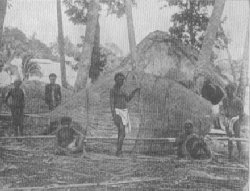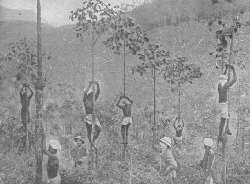|
SHORT SUPPLY OF PLATINUM IN RUSSIA Platinum is growing very scarce. The production last year did not meet the demand, and hence a good deal of concern was manifest during the last part of 1902, as to what, if anything, would take platinum's place in the electrical world. It is beyond doubt that the supply is not increasing—if it is increasing at all—at anything like the same rate as the consumption; and if this condition is not rectified and the balance readjusted it is easy to foresee a time when enterprises which depend upon platinum will languish for want of the material which it will be impossible to secure in adequate quantities, even at famine prices. The metal is in great request in the manufacture of electrical engineering generally as well as for numerous other purposes for which no effective substitute has been found. Something like 95 per cent of the total amount produced in 1901 (13,800 pounds), as compared with 13,250 pounds for 1900, came from Russia, and while it is probable that scientific exploration of the whole of the Urals would lead to the discovery of other sources of supply, it is pretty clear that in the government of Perm little enough progress is being made in spite of the profitableness of the industry. Perhaps the sparseness of the distribution accounts largely for this. The metal is obtained from alluvial deposits of up to four or five zolotniks (the zolotnik is equal to 66 grains Troy) and more in 100 poods of sand (3,610 pounds). The thickness of the beds ranges from three feet to seven feet. The grains of metal are small in size, but sometimes nuggets weighing a kilogram or more are unearthed. The platinum is often accompanied by other rare metals, such as iridium and osmium. It is sent to St. Petersburg in the crude state, and, although there are refineries in that city, very little is dealt with there, and, as the demand for the metal is almost entirely from abroad, the bulk is exported as it is received from the mines. It is said that we must look to New South Wales for the platinum of the future, and it is there that exploration parties are now working. The production of platinum from domestic ores in the United States during 1902 amounted to 94 ounces, valued at $1,814, as compared with 1,408 ounces, valued at $27,526, in 1901, which was the largest quantity reported for any one year since the statistics of the production of the metal from domestic ores have been collected. In 1894 the production of platinum from domestic ores was 100 ounces of crude platinum grains. This amount mainly comes from gold placer deposits in Trinity and Shasta counties, California. Of iridium, which is closely allied to platinum, 20 ounces was obtained in 1902, and 253 ounces in 1901. The United States imported platinum in 1902 to the value of $2,088,980. The market price was about $19 per ounce. FACTS ABOUT NEW GUINEA
THE CINCHONA TREE IN PERU
The cinchona tree grows to a medium height and is bare of branches and foliage except at its top. The natives climb the trunk, which is very smooth, and shave off the bark with knives after the manner of the accompanying illustration. The tree derives its name from the wife of Count Chinchon, viceroy of Peru in the 17th century, who by its use was freed from an intermittent fever, and after her return to Spain, contributed to the general propagation of this remedy. A CUSTOM PECULIAR TO NEW ZEALAND |

